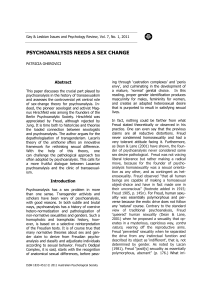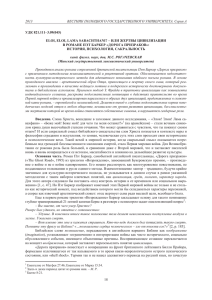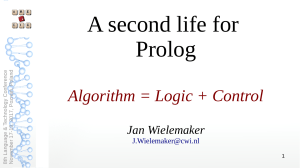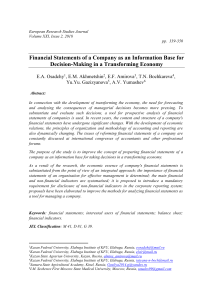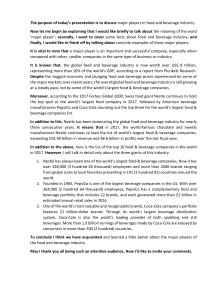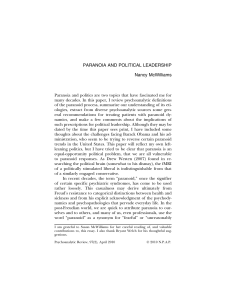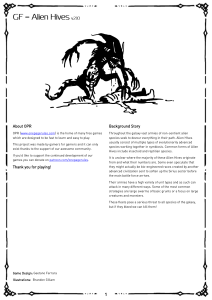Unconscious phantasy Some historical and conceptual dimensions
advertisement
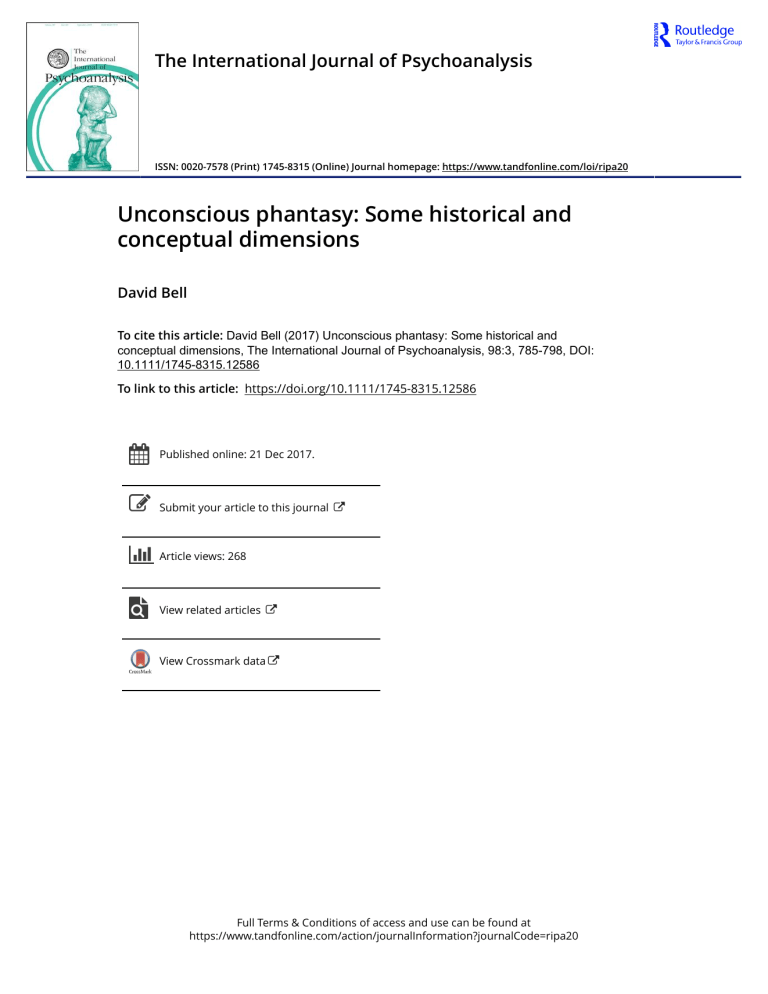
The International Journal of Psychoanalysis ISSN: 0020-7578 (Print) 1745-8315 (Online) Journal homepage: https://www.tandfonline.com/loi/ripa20 Unconscious phantasy: Some historical and conceptual dimensions David Bell To cite this article: David Bell (2017) Unconscious phantasy: Some historical and conceptual dimensions, The International Journal of Psychoanalysis, 98:3, 785-798, DOI: 10.1111/1745-8315.12586 To link to this article: https://doi.org/10.1111/1745-8315.12586 Published online: 21 Dec 2017. Submit your article to this journal Article views: 268 View related articles View Crossmark data Full Terms & Conditions of access and use can be found at https://www.tandfonline.com/action/journalInformation?journalCode=ripa20 Int J Psychoanal (2017) 98:785–798 doi: 10.1111/1745-8315.12586 Unconscious phantasy: Some historical and conceptual dimensions1 David Bella,b a British Psychoanalytic Society, 112A Shirland Rd, London W9 2BT, UK – davidlbell@hotmail.com b Tavistock and Portman NHS Foundation Trust, 120 Belsize Lane, London NW3 5BA, UK (Accepted for publication 16 August 2016) This paper seeks firstly to grasp both conceptually and historically the different phenomenologies that are captured by the term ‘Unconscious Phantasy’. The term is shown to refer to a number of distinct though overlapping conceptual domains. These include: phantasy as scene, phantasy as representation of drive, phantasy as representation of wish as its fulfilment, phantasy as split off activity of the mind functioning under the aegis of the pleasure principle; phantasy as representation of the minds own activities (which Wollheim calls’ the way “the mind represents its own activities to itself’’). Lastly unconscious phantasy is understood as being the basic foundation of all mental life, including drives, impulses, all anxiety situations and defences. Having mapped out this territory through following the development of the concept in the work of Freud and Klein, the author draws on the work of the philosopher Richard Wollheim who, the author contends, has made a fundamental contribution to our conceptual understanding of unconscious phantasy. In the last section of the paper, the author draws a distinction between what he terms ‘objects’ (namely psychic objects) and what he terms ‘facts’. It is suggested that this distinction, though implicit in much of our work, benefits from being made explicit and that in so doing an important dimension of analytic work is illuminated. We aim to help the patient to discover what he is like, to understand the ways in which he conceives and misconceives himself, to unravel the fact-ness of himself and his world from its ‘object qualities’, to differentiate between unconscious phantasy and reality. Keywords: unconscious phantasy, Freud, Klein Wollheim, facts and objects We are all conscious of evil within ourselves, we all have a horror of it and want to get rid of it. Outside ourselves we see evil under two distinct forms, suffering and sin. But in our feelings about our own nature the distinction no longer appears, except abstractly through reflection. We feel within ourselves something which is neither suffering nor sin, which is the two of them at once, the root common to both, defilement and pain at the same time. This is the presence of evil in us. It is the ugliness in us. The more we feel it, the more it fills us with horror. The soul rejects it in the same way as we vomit. By a process of transference we pass it on to the things which surround us. These things, however, thus becoming blemished and ugly in our eyes, send us back the evil we had put into them. They send it back after adding to it. In this exchange the evil in us increases. It seems to us that the 1 Paper given to Conference ‘Unconscious Phantasy Today’, University College London, 8 December 2012. Copyright © 2017 Institute of Psychoanalysis D. Bell 786 very places where we are living and the things that surround us imprison us in evil, and that it becomes daily worse. This is a terrible anguish. When the soul, worn out with this anguish, ceases to feel it any more, there is little hope of its salvation. It is thus that an invalid conceives hatred and disgust for his room and surroundings, a prisoner for his cell, and only too often a worker for the factory. (Simone Weil, 1909–1943) Freud commented more than once that there were three – and perhaps somewhat surprisingly only three – concepts, acceptance of which entitled one to consider oneself an ally of psychoanalysis. These were: the repressed unconscious, transference and infantile sexuality. However, one can see that the concept of unconscious phantasy soon reveals itself as foundational to all. Perhaps this is a timely reappraisal because there is a sense of a shift in the way we use the concept of unconscious phantasy, even an erosion. This involves two distinct manifestations. The first relates to something more general, that raises broad epistemological issues. Here I have particularly in mind ways of thinking, and perhaps the relational school represents this most forcefully, which foreground the interpersonal field and in so doing brings the whole idea of the internal world as such under question. This is distinct from those schools of thought which, though in terms of technique emphasise the relationship between analyst and analysand, remain wedded to the classical model of anxiety, conflict, insight and defence, and so to the internality of psychic life. The second location lies not so much in the model, but in the psychic contents described, for there has been a change in emphasis, a move away from interpreting in terms of archaic bodily processes. Though this has also been an appropriate reaction to the overuse of this language there is perhaps, in the air, a concern to revitalize this. I am reminded of Hanna Segal saying at a conference that as she listened to the papers she recalled the story of an older woman at a party of young people overhearing conversations about sex and wondering to herself, ‘Doesn’t anyone do it the old way any more’! In what follows I would like to rehearse the history of the concept of unconscious phantasy with particular emphasis on the different kinds of phenomena that it covers. I will start with Freud and this will be followed by the Kleinian development of the concept which of course centres on Susan Isaacs’s classical paper. I will show, however, that some of this more contemporary thinking was already present in Freud’s thought, though he did not take forward its implications. This will be followed by some discussion of the work of the philosopher Richard Wollheim, who more than anyone else, has explored the logical geography of psychoanalytic theory, providing a richness that is both conceptual and phenomenological. In the closing section of the paper I will bring a contribution of my own which, I hope, brings some further clarification. We can see that Freud uses this concept in a number of different ways and, as Riccardo Steiner (2003), to whose work I am deeply indebted, reminds us, the complexities and ambiguities of the very term ‘phantasy’ well antedate Freud and reach deeply into its etymology. One of the Int J Psychoanal (2017) 98 Copyright © 2017 Institute of Psychoanalysis Unconscious phantasy 787 tensions which is immediately apparent and which I wish to foreground is that between the use of the word phantasy to refer to mental activities which bear a stamp of lightness, whimsy, perhaps most characteristic of wishes and daydreams, and something more profound, phantasy as expressing deep content of our psychic lives. When phantasy is used in the former way it serves to depreciate the importance of psychic reality (see Isaacs, 2003, p. 158). The second polarity is related to the first, though distinct from it; here phantasy is counter-posed to reality, phantasy is a species of error. This is not without its difficulties as I hope to show in the course of what I have to say. However, though one might be tempted to resist it, as it turns out this polarity seems to be inescapable. These tensions, already present at the very beginnings, continue to exert a continuous pull and affect the way we think of unconscious phantasy, sometimes very explicitly, at other times less so. Perhaps the first major point of departure in the journey of this concept, takes place at the point where Freud gave up trying to make his patients remember events and instead enjoined them to attend to their associations; this marking the first turning of attention away from the patient’s history to the contents of the mind, from the external to the internal. This is followed by the momentous events of 1897 which led Freud to abandon the seduction theory (Freud, 1897), that is to abandon infantile seduction as a necessary and sufficient condition for the causation of hysteria. In recognizing the centrality of phantasy, he not only shifts the focus away from material reality to psychic reality, but gives a causal power to psychic reality. Phantasy is now viewed not only as the product of mental disturbance but also as causing it. These phantasies make themselves known through their repetitive quality. Neurotics no longer suffer from reminiscences but instead repeat the past, that is not only the historical past but the past history of their own psychic lives. In saying that phantasy is no longer the product of neurosis, but its cause, we need to bear in mind that these two aspects interpenetrate each other; that is, phantasy as product of illness can enjoin with the causal pathway of illness, thereby alleviating it or worsening it,2 as I will further discuss below. However, I think it is also fair to say that even when Freud regarded external events as causal for neurosis they were never imagined as being able to have this effect without the intervention of the mind’s way of assimilating these events, in particular in their relation to wishes – without this mediating factor the concept of ‘Nachtraglichkeit’, deferred action, would not be comprehensible. In ‘Formulations on the Two Principles of Mental Functioning’ (1911a), Freud brings a new conceptual clarification by defining for the first time two distinct domains of mental life, that dominated by the pleasure principle and that dominated by the reality principle. Freud writes: With the introduction of the reality principle one species of thought-activity was split off; it was kept free from reality-testing and remained subordinated to the pleasure principle alone. This activity is phantasying, which begins already in children’s play, and later, continued as day-dreaming, abandons dependence on real objects (p. 221). 2 Here I am using Wollheim’s terminology which will be discussed in more detail below. Copyright © 2017 Institute of Psychoanalysis Int J Psychoanal (2017) 98 D. Bell 788 Thinking dominated by the pleasure principle bears close resemblance to the primary process and is bound up with unconscious phantasy. This psychic reality, as Freud says, leads a kind of independent ‘split off’ existence, which, however, is highly consequential for the way we live our lives. In this realm, the reality of thought is equated with external reality, wishes with their fulfilment. This psychical reality dominates over material reality in the neuroses and thus to a varying extent, in all of us. Freud described these phantasies as having strong ties to the sexual instincts and being subject to repression. They are manifest in daydreams and children’s play. This introduces a difficulty which it is as well to foreground now. For is it not the case that the kind of phantasy activity in day dream, in dream and in unconscious phantasy are quite distinct from each other? I think Freud, and here I follow Laplanche and Pontalis (1973),3 is as much pained to emphasize the links between these aspects of our psychology as he is to differentiate them from each other. For Freud the boundaries between different parts of the mind should not be regarded as discrete and fixed, he offers us a better representation: We cannot do justice to the characteristics of the mind by means of linear contours, such as occur in a drawing or in a primitive painting, but we need rather the areas of colour shading off into one another that are to be found in modern pictures. After we have made our separations, we must allow what we have separated to merge again. (Freud, 1933, p. 78) Also we need to avoid a misunderstanding concerning the polarity just touched upon, that between phantasy and reality. For it might be tempting to think that in some sense the acme of maturity would be to live a life dominated by the reality principle, but we know that such a life would be deprived of all the qualities we naturally think of as being part of what it is to be human. There is a matter that is unresolved in Freud, and that is whether there are, from the beginning, some kind of original phantasies that are part of our constitution, our inheritance. In the paper on Leonardo da Vinci of 1910 we see revealed a quite different register of phantasy. Freud describes the way in which Leonardo becomes homosexual. He needs to sustain in his mind a particular scene/phantasy where he is being loved by his mother, and to achieve this he distributes different elements of this phantasy between two figures: himself and his lover. The boy represses his love for his mother: puts himself in her place, identifies himself with her, and takes his own person as a model in whose likeness he chooses the new objects of his love. In this way he becomes homosexual (. . .). (Freud, 1910, p. 100) 3 “It would seem that the Freudian problematic of phantasy, far from justifying a distinction in kind between unconscious and conscious phantasies, is more concerned with bringing forward the analogies between them, the transitions that they share and the transitions that take place between one and the other’ (Laplanche and Pontalis, 1973, p. 317). Int J Psychoanal (2017) 98 Copyright © 2017 Institute of Psychoanalysis Unconscious phantasy 789 Now although we may have doubts about this biographical account of Leonardo, what I want to draw attention to is that here phantasy is not just a scene, not just the representation of a wish fulfilled, but a description of a psychic activity, an inner phantasy lived out in the world. Freud also remarks that in every such situation – that is, where Leonardo takes a lover – he repeats the mechanism by which he acquired his homosexuality. I will return to this shortly. In the Schreber Case (Freud, 1911b) offers a new kind of phantasy content. You will recall that Schreber was a highly intelligent judge who developed a delusional system which centred on his having a special relation to the rays of the sun. He believed that by directing the rays toward himself he could increase his powers whilst at the same time other forces were trying to pull the rays away from him, sapping him of these vital forces. Freud recognized that Schreber’s delusional system has some semblance to his own theory of object libido and narcissistic libido; libido drawn towards the self increases its power whereas libido drained away into the object causes depletion of the self. Freud drily comments: Since I neither fear the criticism of others nor shrink from criticizing myself, I have no motive for avoiding the mention . . . (of) a striking conformity (of Schreber’s delusions) with our theory. . . . these and many other details of Schreber’s delusional structure sound almost like endopsychic perceptions of the processes whose existence I have assumed in these pages as the basis of our explanation of paranoia. . . . It remains for the future to decide whether there is more delusion in my theory than I should like to admit, or whether there is more truth in Schreber’s delusion than other people are as yet prepared to believe. (Freud, 1911b, pp. 78–9) ‘Endopsychic perceptions’, that is the mind’s perception of its own mental activities. Freud has already remarked that in the same way that the sexual perversions led us to understand the vicissitudes of the libido, so the study of psychosis may lead us to understand the ego, and here we have the suggestion that the psychotic mind makes manifest through the medium of phantasy, a representation (admittedly in concrete form) of its own workings. In ‘Negation’ (1925) Freud takes a further step, grounding mental activities in unconscious bodily phantasy. He considers the origins of one of our highest capacities, judgement, as lying in primitive bodily activity. Accepting something as true is swallowing it, and rejecting it is spitting it out or evacuating from other bodily orifices. Wollheim puts this elegantly: Before this (judgement) can happen, a thought is first assimilated to a physical thing that at one moment can be in and the other moment be out of the body; a piece of food or faeces. . .. Thinking is then a physical activity which can bring a thing into or expel it from the body: for example swallowing, vomiting, retaining, defeceating. Bringing this thing in is the origin of assent; expelling the thing from Copyright © 2017 Institute of Psychoanalysis Int J Psychoanal (2017) 98 D. Bell 790 the body is the origin of denial . . . a child curious about his mother’s body, assimilates its curiosity to this physical exploration. (Wollheim, 1984, p. 144) Further we never outgrow this deep connection, it retains its influence .The archaic bodily theory of the mind will for evermore stain and illuminate the ‘minds image of itself’ (Wollheim).4 The work of Klein When Klein decided that children’s play is the equivalent of free association, she not only provided a method for treating young children, she at one and the same time – without perhaps realizing it because it was so natural to her – brought a new conception of the kind of thing phantasy is; phantasies not as scenes or events but as dynamics processes in motion. When one reads Klein’s early papers one cannot fail to be struck by her sustained calm interest in the most disturbing ideas and the ease with which she moves between different psychic registers and can see the transference as saturated in unconscious phantasy. A child who suffered an inhibition in mathematical operations, in his play cuts a woman into pieces, her screaming is stopped by stuffing her mouth with paper and then the child described how the pieces of body were eaten by children. Subsequently Klein reveals the connection between the movements of numbers in mathematical operations and the tearing of flesh, leaving bleeding parts behind – showing how cognition is bound up with these early phantasies. Her abiding concern with intellectual inhibition and its roots in phantasy is well evidenced here (Klein, 1923). In her work, Klein shows how one phantasy impacts upon another, how when one phantasy is analysed another is revealed. Further, phantasy not only colours our world, it is the very medium through which we engage with the world, inner and outer. The earliest operations of the mind, introjection and projection, become properly embodied processes having an almost biological quality. Projection and introjection are to the mind what breathing is to the body. Klein’s technique provided access to more primitive bodily phantasies; the mental phenomena described by Freud in ‘Negation’ now appear as living entities in the consulting room. For Klein (see for example Klein, 1946), phantasies are not some kind of parallel sideshow, but have real effects upon mind, its contents and the way those contents are structured. The individual who says he feels depleted, feels as if he has lost aspects of himself, is not expressing a phantasy in the sense of misunderstanding or error, but instead expresses a kind of insight, or to borrow a term of Freud’s, an ‘endopsychic perception’, of the state of his own mind consequent on projection; those who feel controlled by others, are giving expression to the state of mind consequent on projection of aspects of themselves into others. 4 This concrete form of expression is retained in popular expressions such as: “I won’t swallow that” or “Don’t fill me with your shit, man”. Int J Psychoanal (2017) 98 Copyright © 2017 Institute of Psychoanalysis Unconscious phantasy 791 Through the models of the paranoid schizoid position and the depressive position, Klein provides a framework for understanding the relation between phantasy and different levels of integration. There are distinct varieties of phantasy that characterize these different positions but, more than this, these ways of being in the world are structured by phantasy, movement in and out of them is carried out through the medium of phantasy. It was of course Isaacs (2003 [1943]) who made these features and functions of phantasy explicit — in her work phantasy becomes the very stuff of all mental life. All impulses, all feelings all modes of defence are experienced in phantasies which give them mental life and show them direction and purpose. (Isaacs, 2003, p. 160) Isaacs showed how, when we refer to a defence mechanisms, we are giving a view from the outside, but internally these processes are lived through the medium of phantasy. Projective identification, relocation of aspects of self externally, affects not only how the inner world is represented, but how it is. However, we have also become aware that other processes are brought into play causing the external object to be really affected. This understanding of the way unconscious phantasy is lived out in life and in the consulting room has become one of the most fruitful areas of research and the work of Betty Joseph has been pre-eminent in this respect. I would like to stress here that, as Elizabeth Spillius (1988, p. 83) has pointed out, projective identification remains a phantasy and the effect upon an external object is a matter quite distinct and so cannot, I believe, enter into the definition of this process. The effect upon an external object is better understood, and here I follow Feldman’s (1997) building on the work of Sandler (1976), as the actualization of the phantasy, something conceptually quite distinct. K is a 9 year-old girl returning from a summer break to her first session. As I go to meet her in the waiting room she does not rush past me as she normally does. Instead I find her sitting there calmly, legs crossed, reading a newspaper. I stand there not quite knowing what to do and clear my throat clumsily, somewhat pathetically. She peers over the paper and says ‘I will be with you in a minute’. My young patient has, one might think, managed the break, or maybe the return from the break, through becoming identified with a calm superior analyst occupied with his own concerns, projecting into me a more difficult part of herself. On my appearance she actualizes this internal situation, and does so with remarkable success. So to take stock. We have covered a number of different registers of phantasy: • • • Phantasy as scene Phantasy as representation of drive Phantasy as representation of wish as its fulfilment Copyright © 2017 Institute of Psychoanalysis Int J Psychoanal (2017) 98 D. Bell 792 • • Phantasy as split off activity of the mind functioning under the aegis of the pleasure principle Phantasy as representation of the mind’s own activities (what Wollheim calls the mind’s image of itself (Wollheim, 1969)). And, lastly, phantasy as the basic foundation of all mental life, including drives, impulses, all anxiety situations and defences. It has become the very stuff of our inner world. There is a story about two young fishes swimming in the water on a warm spring day. As they are swimming along an older fish comes towards them. ‘Lovely day to be in the water lads’, he says and swims on. One of the younger fish turns to the other and says ‘What the hell is water?’ That is, unconscious phantasy so colours all our mental life that we live in it, without even knowing it is there. Some further conceptual considerations Phantasy, as we are now accustomed to use the term, is – in a way in which we don’t quite appreciate – a new development as to how we think about mind and it is by no means easy to find the right language to describe it. In certain respects it is a close relation to wishing, but is not wishing; in other respects it has close relation to believing but it is not a belief; all would agree that it gives form to something but it is more than a representation. In my rehearsal of the history of the concept, I am aware that the perspective through which I have viewed that history is deeply influenced somewhat between the lines, by the work of Richard Wollheim. And so now it is time to bring his work more directly into view. Richard Wollheim in The Thread of Life (1984) and On the Emotions (1999) explores what it is to be a person and in so doing makes not only a major contribution to the philosophy of mind but, because he makes such extensive use of psychoanalysis, particularly of Klein, offers us a kind of architecture of Klein’s theory, explores its implications and significance. For Wollheim there is a fundamental division of mental life between mental states, mental dispositions and mental activities. Mental states are occurrent mental phenomena, either conscious or unconscious (for example, thoughts and feelings we are having), which change moment by moment, like the ‘stream of consciousness’, whereas dispositions are background phenomena exerting enormous influence on the contents of consciousness and much else beside. Included in dispositions would be such things as beliefs, desires, knowledge, skills. Mental activities would include perceiving, cognitive operations, psychic acts such as incorporation, projection, identification etc. Whereas occurrent states have subjectivity, that is, there is something of what it is like to have a particular mental state, this is not so for dispositions which are unconscious. Some dispositions will be only descriptively unconscious whereas others are more deeply unconscious, repressed. Mental states express the disposition. These aspects of our psychology have a continuity, they affect each other, that is they are synchronic. Dispositions, however, form a link through time, that is diachronically. Int J Psychoanal (2017) 98 Copyright © 2017 Institute of Psychoanalysis Unconscious phantasy 793 Dispositions have events that establish them: an encounter with a rabid dog may establish the disposition to fear dogs, a very early anxiety situation may establish the disposition to project or introject. Once established this disposition will make itself manifest whenever the appropriate event occurs. There are numerous ways in which mental states and disposition interact: apart from initiating a disposition, as just described, a mental state can terminate a disposition, exaggerate it or attenuate it. Lastly, when an external event causes a mental state it can never do so simply, it can only do so through an interaction with other dispositions – gunfire will be likely to have a very different meaning to a soldier than to a man walking down the street. And now to the point that is most relevant to our subject. Certain dispositions are lived as phantasies and when these phantasies or derivatives of them become conscious, the mental states make manifest the nature of the relevant disposition. For example, the disposition to be jealous will become manifest, that is expressed as a mental state, when something external or internal triggers it. And if it is dispositions that carry our history, and if these dispositions are in the large part phantasies, then it is phantasy that carries the mark of our history, that install us within the narrative of our own lived lives, they are the ‘thread’ of our personhood. Whereas philosophers had tended to see continuity through life as carried by memory alone, for Wollheim it is carried by memory conjoined with phantasy. Memory conveys information, phantasy conveys and preserves influence. Phantasy then manifests itself as mental state, as disposition and as mental activity. Phantasies according to this account are self-reinforcing, that is, it is somehow in their nature to preserve themselves and to preserve their influence upon us. Here I return to Leonardo. You recall Freud’s stating that in every situation where Leonardo takes a lover ‘he repeats the mechanism by which he acquired his homosexuality’. That is, in Wollheim’s terms, the living out of the phantasy acts to preserve it and to maintain its causal relation to the event that initiated it. The most primitive phantasies are internal representations of desire or, perhaps more accurately, the representations through which desire is fulfilled. In the earliest situations, which however maintain their causal force, desire is satisfied through actual hallucination of the breast- the progenitor of phantasy as wish-fulfilment. At a different level phantasy acts not so much to bring pleasure but to relieve anxiety (this can also be thought of as a release of unpleasure) and here Wollheim has in mind such things as the projection of some anxiety provoking aspect of oneself into the outer world, or the introjection of a frightening object for purposes of control. This immediately leads on to the next level, namely the phantasies that are consequential on these early defences. For example, introjection results in our disposition to phantasize figures inside us, at first in simple and then in increasingly complex relations with each other. Lastly Wollheim considers phantasy an essential element in the formation of emotion. And it does this through providing the basis for an attitude: feelings of rage, for example, may carry the phantasy of tearing, biting an object and so on. Copyright © 2017 Institute of Psychoanalysis Int J Psychoanal (2017) 98 794 D. Bell Phantasies have a fluidity, and they can, as Klein showed, affect each other. They can undergo changes, though deeper phantasies are more resistant to change. Though phantasies are by no means purely pictorial, the earliest phantasies are physical ‘memories in feeling’, as Klein put it (Klein 1957, p. 179), we normally think of them in pictorial forms and in these forms that they have greater accessibility. The contents of phantasy have distributed through them conflicting elements (such as conflicting desires). This distribution can be in time (the rat man separates his murderous wishes, enacted by putting the stone back on the road, from his loving ones, that is removing it to protect his lady). Or they can be distributed pictorially through different parts of a phantasy scene. Phantasies condense contradictory meanings into a narrative structure. Thus phantasies solve a problem in the same way, as the philosopher Sebastian Gardner5 has suggested, that a pictorial portrait might solve a problem of composition. Facts and objects Before finishing this part of the discussion I would like to return to a polarity that I raised as problematic at the beginning of this paper, namely phantasy versus reality. l had at first thought, as I said, that this polarity was somewhat inappropriate, that we need to get away from it, as phantasy here becomes a species of error, positing perhaps some state in which it can be transcended, and as is clear from the above, this is neither possible nor desirable. There is no phantasy-free state, even contact with reality has to be supported by phantasy structures. If we think of an astronomer looking through his telescope we may imagine that his marvelling at heavenly bodies, full of wonder and curiosity, harks back to his earliest sense of the wonder of his mother’s body. This kind of example goes against thinking in terms of phantasy versus reality, as here phantasy supports the investigation of reality as Klein so clearly showed. However, I now see that this distinction, though not without its problems, retains a necessary force. Gardner has suggested to me that the relevant distinction might be thought of as that between background phantasies (which have a dispositional quality) versus phantasies that obtrude into consciousness, and do so in particular ways. In the case of our astronomer, were the phantasies to obtrude, he might get so excited that he ceases to be able to observe properly, may imagine he has seen things he could not possibly have seen, or alternatively he may become inhibited and cease to be able to do his work at all – in Segal’s terms this is symbolic equation replacing symbolism proper (Segal, 1957), in Bion’s terms a failure of alpha function. There is another polarity in mental life which, though not the same as that of phantasy versus reality, is closely related to it. I call this distinction that between ‘facts’ and ‘objects’. I will explain what I mean. 5 Personal communication. Int J Psychoanal (2017) 98 Copyright © 2017 Institute of Psychoanalysis Unconscious phantasy 795 Some time ago, I heard an AIDS worker describing a difficulty in his work somewhat along the following lines: ‘It seems very hard for people to understand that the HIV virus is just that – a virus, doing what viruses do. It has no intention of harming anyone. It is really just an unfortunate fact that in replicating itself inside human beings it happens to kill them, but it is no easy matter for people to think of it in this way.’ We think of the virus, and this spreads out to all diseases, as harbouring intentions – it is attacking us, we need to defend ourselves, and so on. That is we tend to regard diseases as if they were internal intentional objects causing us damage, rather than the virus and the disease it causes being mere facts, unfortunate and unhappy facts, but facts nevertheless. What starts life as a virus transforms in our mind and takes on the characteristics of a psychic object. In Wollheim’s terms, we are heavily disposed to view the virus as embodying a particular dispositional phantasy. Susan Sonntag (1978) has explored these metaphors in relation to disease. But of course they are more than metaphors. The kind of distinction that this illustrates marks something much more general: a division that spreads across all mental life and one that we are all keenly aware of in our work, although we tend not to make it explicit. That is the distinction between ‘facts’ and ‘objects’ or perhaps more accurately the distinction between what we apprehend as a fact and what we apprehend as an object. Death, for example, is easily misunderstood as a psychic object, often one that is pictured, personified, as catching up with us, triumphantly showing us we can never escape etc. This distinction which I have here foregrounded rests very heavily on the workings of unconscious phantasy, for it is clear that the transformation of a fact into an object can only be achieved through the intervention of the relevant dispositional phantasy. If I do something bad, I have the unhappy experience of knowing it is bad and this may bring the appropriate feelings of shame and or guilt. But this is never so straightforward. For once I experience these emotions, I start, characteristically, to feel persecuted and this so easily slides into ‘I am being persecuted for what I have done’.6 That is, I am now at the mercy of an object and as this object has a history (Wollheim’s term here would be a narrative) it is inextricably intertwined with that history, perhaps the history of all my other wrong doings, real and imagined. Not infrequently a further move takes place: I may lose sight of the guilt I felt and start to feel I am being forced to feel bad, they (as it is projected outwards) are making me feel bad. (Wollheim illustrates this process in the character of Raskolnikov in Dostoievsky’s Crime and Punishment). These transitions mark the traverse from fact to object first internal, then external. They are instantiated through the medium of the relevant (dispositional) phantasies. A further example: I feel excluded from the primal scene. This is again a fact, in this case a fact of life, but this can be misconceived as ‘They are 6 Klein makes this point when she says “If premature guilt is experienced by an ego not yet capable of bearing it, guilt is felt as persecution and the object that arouses guilt turns into a persecutor” (Klein, 1957, p. 194). Copyright © 2017 Institute of Psychoanalysis Int J Psychoanal (2017) 98 796 D. Bell making me feel bad, they are flaunting their sexuality and purposely filling me with jealousy’. Or the breast that is absent (an unhappy fact) becomes a breast that is withholding, a characteristic type of object, and one that has a paranoid colouring. In these examples a sad fact has become a malign object. Segal (1950) describes a psychotic man who, when she tells him he fears breaking down, a fact-like observation, misunderstands her as forcing a breakdown into him. A less disturbed patient of mine assumes that when I talk about the break I am merely indulging my narcissism and trying to force her into a position of depending upon me. Note, however, that the individual who mistakes a fact for an object doesn’t know he is doing this; for him it is just a fact – for example the fact that the analyst wishes to humiliate him. Britton makes the same point in relation to beliefs, that is what the analyst regards a belief his patient takes as fact (see Britton, 1998, p. 12). Of course, there are situations where a couple have intercourse in order to fill the baby’s mind with rage and jealousy and there are situations where the mother deliberately withholds for the sadistic pleasure of it. But these are not the situations I am referring to, although their pathogenicity does to some extent derive from the external situations giving form and validity to these phantasies. Perhaps the most difficult facts for us to manage are the facts of what we are like as people. If I am aware that there are parts of my nature that it would be impossible for me to like, then I am called upon to tolerate this fact. But it is extraordinarily difficult to hold on to these things as facts and indeed to do so we need to be supported by phantasied benign inner objects whose capacity to accept us for what we are supports our own capacity to accept ourselves (a matter in which we waver continually, particularly as acceptance can so easily become idealization). I have described an ever present tendency to misunderstand facts as objects. But the reverse is also true, we misunderstand objects as facts and this is characteristic of certain psychotic states. A melancholic views his worthlessness as fact – a patient of mine, a talented writer, is convinced that her work is worthless, a terrible fact. She could not see that this was not an objective judgment, but masochistic submission to an envious inner object. An important caveat. If I were sublimely able to see my wrong doings or to recognize aspects of my character that are unpleasant, and to view this only as a fact, with no influence of phantasy, my experience of myself would be devoid of all that makes us human. That is, it is something of what it is to be truly and deeply aware of the significance of such facts that they are conjoined with emotions and those emotions will colour that ‘fact-ness’. There is a distinction to be drawn between the apprehension of such facts about ourselves, our judgement of them, in a world coloured by the depressive position, as opposed to the paranoid schizoid position. In the latter such facts become, I suspect, either unbearably persecuting objects, or alternatively mere facts devoid of any feeling at all: the former we think of as paranoid, the latter as schizoid, depersonalized states. Int J Psychoanal (2017) 98 Copyright © 2017 Institute of Psychoanalysis Unconscious phantasy 797 It is also I think the case that a considerable part of the work of analysis involves helping the patient to discover what he is like, to understand the ways in which he conceives and misconceives himself, to unravel the factness of himself and his world from its object qualities, to unravel the object qualities from their apparent, fact-ness. Further the analyst is not only experienced as a kind of object, he get pushed into becoming one, and the understanding that emerges from moving in and out of this process has become for us a central part of the work. Concluding comments The concept of unconscious phantasy covers a very wide terrain which I have attempted to explore in this paper. I am aware, though, that the result is not tidy – phantasy seems to be so many different things at the same time. However, we should not expect too much conceptual neatness if we are to do justice to the complexity of the object of our investigation. Freud recognizes this problem. Our wish to have a map of the mind that has well-ordered contours and dividing lines, finds a fitting metaphor in the maps of political geography. The lines dividing countries, or separating different agricultural forms, he reminds us, are artefacts which, when you lift your eyes from the map and actually go and see what is there, have to be surrendered. He writes: The probability is, however, that you will find less orderliness and more mixing, if you travel through the region. Germans, Magyars and Slovaks live interspersed all over it; in the hill-country there is agricultural land as well, cattle are bred in the plains too. A few things are naturally as you expected, for fish cannot be caught in the mountains and wine does not grow in the water. Indeed, the picture of the region that you brought with you may on the whole fit the facts; but you will have to put up with deviations in the details. (Freud, 1933, pp. 71–2) There remains the question as to the fate of the disturbing phantasies that have dominated an individual’s mind, maybe an archaic punishing superego. How can they change in life, or in analysis? Do these phantasies change in their nature, or is it that they remain, but we are more insulated from their effects? Could we distinguish between these two situations? I think the likelihood is that such disturbing phantasies remain, remain as dispositions, but do not dominate so much, they take their place amongst others, so bringing more flexibility to the personality. But inevitably they will erupt from time to time. Wollheim writes: “A person leads his life at a crossroads: at the point where a past that has affected him and a future that lies open, meet in the present”. Psychoanalysis lives exactly on this crossroad. Our work aims to interrupt past determinations, through discovering them as living entities, phantasies, in the present. We aim not to rid the mind of any phantasies Copyright © 2017 Institute of Psychoanalysis Int J Psychoanal (2017) 98 798 D. Bell but more for the individual to come to learn how his life is stained and illuminated by them, and so understand himself better. References Britton R (1998). Belief and imagination. London: Routledge. Feldman M (1997). Projective identification: The analyst’s involvement. Int J Psychoanal 78:227–41. Freud S (1897). Letter 71 Extracts from the Fliess Papers. SE I:263–6. Freud S (1910). Leonardo Da Vinci and a memory of his childhood. SE XI:57–138. Freud S (1911a). Formulations on the two principles of mental functioning. SE XII:213–226. Freud S (1911b). Psycho-analytic notes on an autobiographical account of a case of paranoia (dementia paranoides). SE XII:1–82. Freud S (1925). Negation. SE XIX:233–40. Freud S (1933). New introductory lectures on psycho-analysis. SE XXII:1–182. Isaacs S (2003 [1948]). The nature and function of phantasy. In: Steiner R, editor. Unconscious phantasy. London: Karnac. Klein M (1923). Early analysis. In: The writings of Melanie Klein, Vol. 1, 77–105. London: Hogarth. Klein M (1946). Notes on some schizoid mechanisms. Int J Psychoanal 27:99–110. Klein M (1957). Envy and gratitude in envy and gratitude and other works 1946–1963. London: Virago. Klein M (1975). Envy and gratitude and other works 1946–1963. In: International psycho-analytical library, Vol. 104, 1–346. London: The Hogarth Press and the Institute of Psycho-Analysis. Laplanche J, Pontalis JB (1973). The international psycho-analytical library, Vol. 94, 1–497. London: The Hogarth Press and the Institute of Psycho-Analysis. Sandler J (1976). Countertransference and role-responsiveness. Int Rev Psychoanal 3:43–7. Segal H (1950). Some aspects of the analysis of a schizophrenic. Int J Psychoanal 31:268–78. Segal H (1957). Notes on symbol formation. Int J Psycho-Anal 38:391–7. Sonntag S (1978). Illness as metaphor. In: Illness as metaphor and AIDS and its metaphors. New York: Picador, 2001. Spillius E (1988). Melanie Klein today, vol. 1 Mainly theory. London: Routledge. Steiner R (2003). Introduction. In Steiner R, editor. Unconscious phantasy. London: Karnac. Wollheim R (1969). The mind and the mind’s image of itself. Int J Psycho-Anal 50:209–20. Wollheim R (1984). The thread of life. Cambridge: Cambridge UP. Wollheim R (1999). On the emotions. New Haven, CT: Yale UP. Int J Psychoanal (2017) 98 Copyright © 2017 Institute of Psychoanalysis

